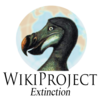Talk:Wood harrier
| This article is rated Start-class on Wikipedia's content assessment scale. It is of interest to the following WikiProjects: | |||||||||||||||||||||
| |||||||||||||||||||||
Wrong category
[edit]Why is this animal listed under the New Zealand extinct animals category if it lived in Hawaii? That's over a thousand miles away. 97.104.210.67 (talk) 00:40, 17 March 2010 (UTC)
- Yes, an obvious mistake. Now fixed. Maias (talk) 05:22, 17 March 2010 (UTC)
Temporal Range
[edit]Due to recent (mid-2018) and repeated disruptive editing of the temporal range for the species described in this article, I am inserting on this Talk Page the following quotes from one of the main references upon which this article is based ("Descriptions of thirty-two new species of birds from the Hawaiian Islands: Part I. Non-Passeriformes" by Storrs L. Olson and Helen F. James, 1991).
- Regarding the type locality for this species: "The only date for this area as yet is from land snail shells . . . which indicated an age of about 25,000 yr (Stearns 1973). Because of difficulties with exogenous carbon in land snail shells, this must be regarded as a maximum age." Regarding Barbers Point where the remains of this species were also found: "Radiocarbon dates on material from sinkholes near Barbers Point fall in the latter half of the Holocene".
- In reference to all species described in the paper: "These remains are mostly of late Holocene age."
Given the above, and additional comments by the authors such as "Prehistoric avian extinctions in the Hawaiian Islands are attributed mainly to predation and environmental degradation by Polynesians and introduced predators" and, most tellingly, "Had not Homo sapiens arrived in these islands some 16 centuries ago, these birds would still be alive today", I feel it is accurate to describe this species (as well as the others described in the paper) as being all but contemporaneous with modern birds -- that is, with a temporal range of "Late Holocene". Kiwikiu (talk) 02:52, 26 June 2018 (UTC)



